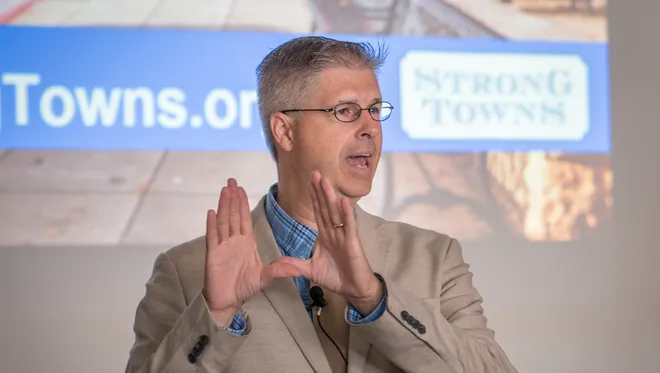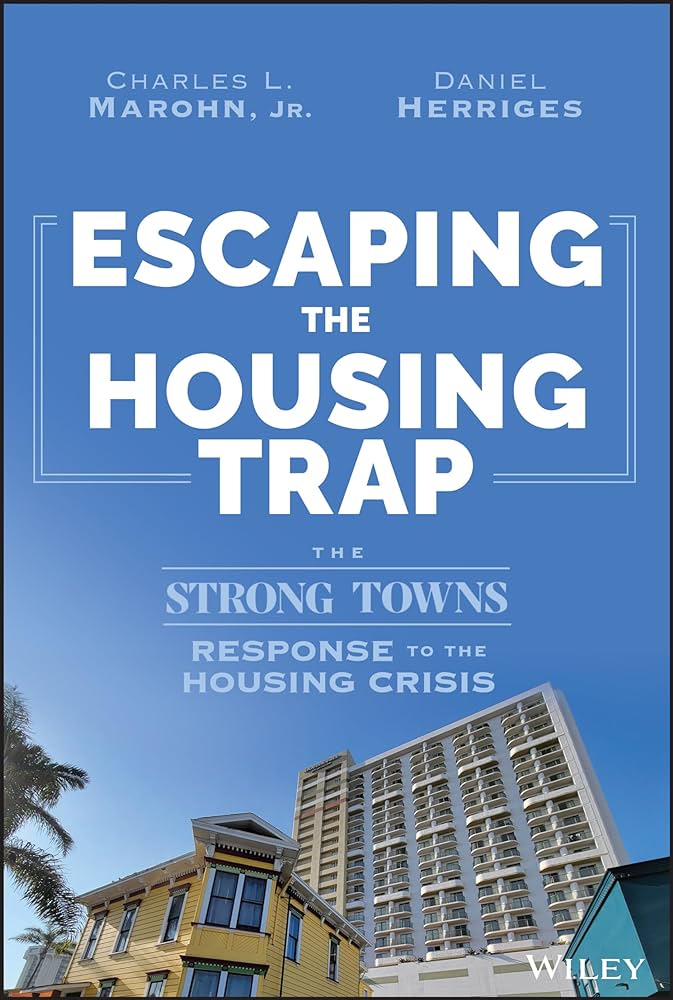[Cross-posted to Wichita and the Mittelpolitan]
The core of Chuck Marohn’s message to America’s towns—specifically, the necessity of working incrementally to recover the practices of fiscal, environmental, and social sustainability that, in his view, once characterized the great majority of American cities but, thanks to the automobile and the suburb and all the policies and preferences which incentivize them both, have been mostly lost—hasn’t much changed throughout the history of Strong Towns, the civic organization he founded 15 years ago. What has changed, though, are both the practical recommendations that follow from applying his message to various public policy concerns.
In his first book, Strong Towns: A Bottom-Up Revolution to Rebuild American Prosperity, with its focus on bringing stable wealth-building back into our communities in contrast to debt-driven growth, he ultimately implied, at least in my view, a kind of republican prudence as the alternative to the capitalist and statist Ponzi schemes by which most North American municipalities operate today. In his second book, Confessions of a Recovering Engineer: Transportation for a Strong Town, his main point—again, as I read him–was to make clear how thoroughly undemocratic are the unsafe and economically unhealthy transportation systems which structure so much of our civic life really, and that developing alternatives would mean reviving real participatory political action. While there is much that distinguishes those two works, Marohn’s careful, detailed, insistent demands that America’s urban communities wean themselves way from the bells and whistles of unsustainable, built-to-finsh growth—the soaring six-lane overpasses, the luxurious new baseball stadiums, the monorails, almost all of which inevitably carry with them bankrupting liabilities and almost all of which regularly fail to generate the jobs and tax revenues promised—and instead slow down, step back, and think again, is a constant.
This is what makes his latest, just-released book, Escaping the Housing Trap: The Strong Towns Response to the Housing Crisis, this time co-authored with Daniel Herriges, somewhat different. For the first time—at least when it comes to his book-length publications—Marohn is arguably eschewing his oft-attributed (and, I think, partly inaccurate; see more below) small-c conservatism and calling instead for expansion and growth. It’s almost a mantra throughout the book, from “the path to escaping the [housing] trap will require a building boom” (p. xvi) in the Introduction to “anyone who claims to support a Strong Towns approach must be committed to rapidly adding new housing units” (p. 186) in the second-to-last chapter. How does he justify this change—if in fact it is one?
In some ways it isn’t—his frustration with the way expansionary thinking, both political and economic, has, in his view, deeply compromised the ability of our built environments to adapt as they once did to the human needs, projects, struggles, and virtues that ought to characterize every community is as great as ever. But Marohn acknowledges that housing poses a somewhat different problem than does city budgets or city streets, a problem that would only be worsened by stepping back, instead calling for a renewed, if differently focused, engagement. Why? For one thing, while undermining local economic development through handing out corporate tax breaks or destroying neighborhood integrity through submitting to the demands of automobile commuters are damaging and complex urban problems, they are not problems which, by their very existence, create their own financial justifications, as warped as they may be. Housing, however, does. As Marohn and Herriges spend more than a third of the book explaining, the ridiculously costly, too often perversely regulated, and far from sufficient market for housing that exists in America today has become, in fact, a financial necessity:
The housing market is our source of shelter, but it is also the foundation of the American economy. Investments whose values are derived from home mortgages literally backdrop the solvency of the entire banking system. This is a lesson we learned the hard way in 2008, and yet it remains true today. Not only the financial sector but millions of individuals’ finances are dependent on equity in a house they hope will be an appreciating asset over time…
The primary purpose of a house today isn’t to provide shelter. That is such an old-fashioned, quaint way to think about housing. No, the primary purpose of a house is to create a piece of mortgage paper, a financial instrument that can be brokered, transferred, bundled, securitized, hypothecated, traded, collateralized, and gambled with. It is a piece of paper that represents the future earnings of each of us…
We are trapped. This is a cycle that can only go in one direction. Housing prices may correct a little, but they can never be allowed to fall to a level that would be considered affordable… It is a financial trap, of course… It is also a regulatory trap…Finally, it is a cultural trap…. To escape the trap, we must overcome the basic contradiction that housing can be both affordable and a good investment, more than just a store of wealth (pp. x, 10-11).
The reality of the America’s housing dilemma thus mandates a solution that would do several things simultaneously: “rapidly add new housing units at affordable prices; not adversely impact the existing housing market; allow for the flow of capital into [a] community [while slowing] the flow of capital out of [a] community; and grow [a] city’s tax base without adding to the liabilities of local governments.” Unfortunately, as Marohn and Herriges trenchantly comment, “there is no approach currently on offer that allows these things to happen… no set of Wall Street investments, [no] federal programs or subsidies, [no] top-down housing initiatives capable of working even close to these parameters” (pp. 154-155). Hence, if we are do anything to address much-too-high home and rental prices (which is absolutely tied to the total amount of housing stock), and if we are to do anything to address American’s increasing homelessness problem (which again, more than one might expect, is also absolutely tied to the total amount of housing stock), some radical re-thinking of both housing and our finance system (or, to their mind preferably, multiple revived local finance systems), as described in the final chapters of the book, is imperative.
Are they correct? In terms of laying out the economic and structural problems with housing construction and costs in America, I think so. I am not an economic historian, nor a financial analyst, and I’m sure both of those and more could point to gaps or mistakes or false emphases in the history and analysis which Escaping the Housing Trap provides. (At the very least, I know that the role of centralized planning and financing in American urban development throughout the 19th and early 20th centuries was not quite as small as they insist.) But what I am mostly, insofar as this discussion is concerned, is a homeowner and an attentive U.S. citizen. I lived through and followed the news during the related mortgage and financial crises of the Great Recession in the late 2000s, and I can recognize that the amount of consumer debt that my wife and I carry, and the two times we have refinanced our 30-year mortgage so as to take out equity from our home to help pay down some of that debt (and pay for braces for our children, and pay for a once-in-a-lifetime family trip), fits very well into the complex tale Marohn and Herriges tell, and I find that persuasive.
Their case is made even stronger by refusing to suggest that any one factor alone built the trap we are in. They cast a sharp eye at zoning, federal policies, suburban aspirations, financial deregulation, and more, but also insist that there’s every reason to believe that almost all of these bankers, reformers, policy-makers, developers, city officials, and homeowners like ourselves over the past century, were genuinely making what seemed to them at the time reasonable choices to deal with real problems. Hence their conclusion that we have all (mostly) unintentionally built this maddening trap for ourselves makes intuitive sense. Even if Strong Towns’s particular approach to localism isn’t your cup of tea, the chapters where they quickly, yet never simplistically, lay out what they see as dozens of little-noticed contributing factors to this trap (the insurance industry’s backing of 1927’s Uniform Building Code, developer J.C. Nichols’s 1948 dangerous “Planning for Permanence” vision, the federal reforms which allowed savings and loan institutions to massively expand in the 1980s, the consequences of an effective zero interest rate policy in the 2010s, and much more) deserve a close read.
So much for causes. What about their engagement with the culture of homeownership in America and their recommendations for nudging or reforming that culture’s rules and practices back towards something more affordable and sustainable? They make many, and most seem entirely reasonable to me: that “cities simply stop enforcing code provisions that impede the desperate housing needs of their residents” (p. 96); that cities enable and encourage “a multitude of local experiments in cooperative housing,” pointing to models that have worked well in Germany, Austria, Singapore, and elsewhere (pp. 143-145); that cities use “a micro form of… Tax Increment Financing” to provide the “patient capital” that might enable “converting underutilized rooms to studio apartments [and] installing backyard cottages” (pp. 187-191); that cities adjust parking and zoning requirements so that “neighborhood-scale commercial enterprises” can thicken up the interactivity which drives development opportunities (p. 160); that basically, “in the short term, there are very few policies and projects that add more housing units” which cities shouldn’t consider giving a shot (p. 163). Overall though, what they are calling for isn’t so much a new solution as a new paradigm for thinking about housing—and that is where the aforementioned, and complicated, issue of Strong Towns’s politics comes into play.
Several months ago, Allison Lirish Dean, an urban planner and journalist based in North Carolina, wrote a long, detailed, and somewhat polemical essay which described Strong Towns as “right-libertarianism dressed in progressive garb.” As a long-time Strong Towns supporter and someone who both definitely isn’t a right-libertarian and doesn’t see that ideology implied by Strong Towns’s approach to these issues at all, my initial take on her piece was quite critical, even as I recognized the validity of many of her arguments. Thanks to Elias Crim at Solidarity Hall, I was able to interact with Allison, pressing her about several of her observations, and I came to understand her concerns much better, and sympathize somewhat with her approach. Her particular claims regarding public transit, water infrastructure, and especially housing reflect political and socio-economic realities that are important to keep in mind—most crucially, the important role that federal funding and central planning can and should still play in urban policy, given the financial restrictions which limit cities’ ability to raise revenue and the decades of tax policies that have left once robust public services chronically underfunded, all of which can tragically serve to, as she put it in her conclusion, “naturalize austerity and infrastructure inequality.” But even beyond those particular positions, there is also Strong Towns’s frequent determination to present itself as non-political, as solely committed to providing information to help urban communities address wholly empirical realities. That determination—which Strong Towns and Marohn himself strongly affirmed after Dean’s article came out—reflects a well-intentioned desire not to alienate potential allies while building support for these complex nudges and reforms. At times, though, it can also sound–to scholars of political ideas like myself, anyway–like an attempt to bracket political values entirely, which can turn important critical concepts like “localism,” “incrementalism,” or “citizen-empowerment” into simple methodological preferences, into which others–some of which do not take Strong Towns’s civic concerns seriously at all–might pore all sorts of ideological contents. To avoid this, and to advocate for these concepts as Marohn and Herriges do in Escaping the Housing Trap more properly, one must fully address the political realities and alternatives that valuing this more participatory and decentralized approach either embraces or sets aside.
The surprising part of all this is that there are parts of this book which can be read almost as a response to Dean, with the authors carefully underlining the debates over political values they cannot help but wade into. As they write while acknowledging controversial successes the not-for-profit “social housing” model, the “debate about to what extent basic necessities should be provided by the market or provided by the state” is “never-ending” since “reasonable places will land in different places” (p. 145). They recognize that “there has not been a free market in housing in a very long time,” and that given “the provision of public infrastructure such as roads, one could argue there has never been [one]” (p. 146). But they also realistically insist–and I do not believe they are wrong to do so—that so long as we agree that “there can be no return to the pre-Depression status quo, in which housing at the bottom run of the ladder was plentiful and cheap but also frequently unsanitary and unsafe,” but also so long as “federal law (the Faircloth Amendment to the Public Housing Act, passing in 1998)…prohibits any net increase in public housing units” (pp. 139, 147), the structural concerns of politically attuned observers like Dean (and myself) will, I think, have to stand as a critical accompaniment alongside the more immediate, but also necessarily incremental, work that has to be done. Getting broad-based home-building happening again means making local compromises, both supporting developers but also working to break those builders and their supply chains away from restrictive, suburban, single-family models and getting our housing supply to diversify as well.
It’s important to note, though, that “local compromises” don’t imply that one is solely involving those developers and residents and policy-makers which are making use of local resources alone. On the contrary, effectively freeing cities and towns, including by state edict, to be able to bring together local actors—many of whom are functionally extracting unwarranted rents from their communities, preventing in-fill development and locking in existing built infrastructure in the name of preserving (sometimes) parkland or (more often) property values and parking spaces—and make these compromises is entirely compatible with the Strong Towns localist vision. Which is why Marohn–who was born in, and started ST in, and continues to live in, Minnesota–has been so involved with trying to get his elected representatives to put an end to local requirements of parking minimums throughout the state, requirements that do nothing except force upon residents overlarge commercial developments and unwalkable streets, because every shopkeeper and street designer, under various municipal mandates, has no option except to make far more space for cars than necessary. (That the “People over Parking Act” was introduced by Democrats and has been promoted by democratic socialists among multiple other groups, is an interesting addendum to the argument about the small-c conservative political values which incrementally striving for greater citizen empowerment and urban adaptability supposedly entails.)
Marohn and Herriges don’t explicitly discuss this legislation, but they get the general idea behind it across in one of the book’s most important chapters, where they address sympathetically but also firmly the NIMBY (“Not-In-My-Backyard”) mindset, an attitude that they admit often draws upon solid Strong Town principles, but which also, as they put it (and here they quote Jane Jacobs), regularly confuses preserving the integrity of the complex, living communities residents are part of with “taxidermy”:
One measure of local control is how much the community, through its representatives, can influence or restrict the development process…. An affirmative vision of local empowerment would include not just public meetings, comment forms, and a consultation, but also the freedom to build. Top-down power may be a useful tool in securing that freedom. The collective action problem faced by local governments is very real: coordination may be required to better align the incentives of multiple cities in a region. This power should be thought of less as a set of mandates than as a set of guardrails.
Higher levels of government should always exist in service to local and immediate needs. There is a case that states have a role in saving cities from themselves…. The anti-localist crowd of pundits tends to miss this point…. NIMBYism and the problems we can lay at its feet are not the result of an excess of localism. If anything, they are manifestations of centralization and the disempowering of people to make productive change in their own backyards (pp. 111-113).
As I wrote before, I’m not an economic historian or a financial analyst, much less a civil engineer like Marohn or an urban planner like Herriges; I’m a scholar of politics and political ideas, and as such I see things through that prism. Hence, I can honestly applaud everything in this passage but also, like Dean, perhaps squirm a little at the nominally apolitical, but nonetheless potentially libertarianish, implications of that final sentence. After all, if we are to be frank about political matters, just what is the “centralization” that, as the book presents it here, warps responsible citizens into joining the (too often historically classist or racist) NIMBY camp, and thus opposes increases housing density and affordability? I would argue (as I alluded to above) it is at least as much the centralization of financial jurisdictions as anything else. With municipalities usually forbidden by law from using equitable forms of taxation to democratically collect the resources necessary to work with and through their own citizens to make compromises and articulate a common good, defensiveness on the part of the locals when it comes to investors and land-owners pursuing comprehensive, top-down developments (the upscale suburban tract! the hotel and Top Golf entertainment complex!), which they rightly see as the most efficient way to make a dollar, actually is sensible. As before, I think the best understanding of the Strong Towns message is more political than its promulgators know; they are talking about finding ways–including, sometimes, ways of using state power–to make people feel like citizens of their places again, where collective decisions about the built environment, and the way it is paid for, are truly in their hands, not corporate ones.
All of this only touches the surface of Escaping the Housing Trap’s arguments and only begins the many productive discussions that should—and hopefully will!—follow in its wake. Buy and read the book, and join with your neighbors in talking about how Strong Towns can help make your community a place that can house all who need it.













